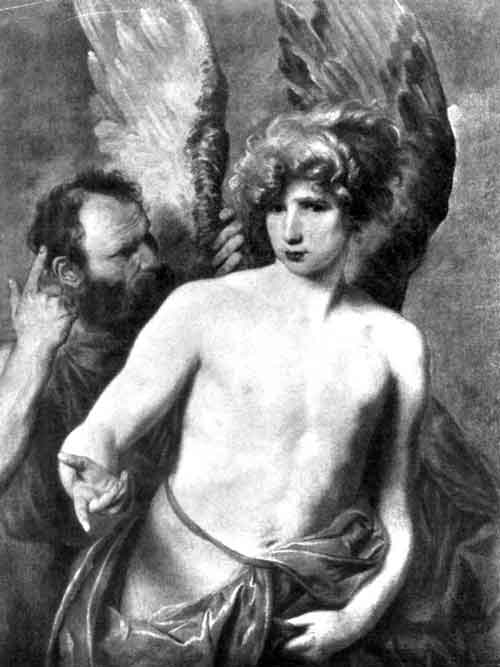.

ESTELLE M. HURLL:
In the distant past which we call the age of fable lived the cunning craftsman Dædalus of Athens. One of his most curious inventions was a labyrinth which he constructed for Minos, the king of Crete. Having at length displeased this king he resolved to flee from the island with his son Icarus. It was impossible to escape by way of the sea without detection, but Dædalus was not discouraged.
"Land and wave,
He cried, deny me way! But Heaven above
Lies open! Heaven shall bear me home!"
quotations are from Ovid's Metamorphoses, Book viii., translated by Henry King.
So saying he began to fashion some wings with which he might fly away. Feathers of different lengths were bound together with thread and wax, and shaped into arched pinions like those of a bird. As he worked, the boy Icarus stood by watching his father, and sometimes handling the feathers with his meddlesome fingers.
At last the final touch was given, and Dædalus, fastening the wings to his body with wax, made a short trial flight. The invention was a success; the artist rose triumphant in the air. Then he taught his boy the use of the wings, warning him of every possible mishap:—
"'Midway keep thy course, he said,
My Icarus, I warn thee! if too low,
The damps will clog thy pinions; if too high,
The heats relax them. Midway hold thy flight.
--------------------------------------------------------------------------------
By mine
Thy course direct.' And many a precept more
He gave, and careful as he bound the wings
Upon the shoulders of the boy, his cheeks
Were wet with tears, and in the task his hands
Paternal trembled."
ur picture illustrates this point in the story. Dædalus has just fastened the wings upon his son and is giving the final directions. The old man's face is full of anxiety, as he implores the lad not to fly too high. Icarus listens to the advice with a shade of impatience, pouting a little, like a wilful child who chafes under restraint. He points forward, as if to show that he understands his orders. Already the slender figure is poised for flight; he is eager to be off. In another moment he will rise into the air, dropping his garment as he ascends. A light breeze flutters the soft plumes of the wings and blows the loose curls about the boy's head. His youthful beauty, almost feminine in type, contrasts finely with the strong furrowed countenance of the father.
The story goes on to tell how the two started off together, the father leading the way.
"And, as the mother bird
When first her offspring from the nest essays
The air, he hovered anxious, cheering on
The boy to follow, and with fatal art
Enjoining thus or thus his wings to ply
As he example gave."
For a while all went well, and they had covered a long distance, when Icarus,—
"Elate
With that new power, more daring grew, and left
His guide, and higher, with ambitious flight
Soared, aiming at the skies!"
This was the very danger against which Dædalus had warned his son.
"Upon his wings
The rays of noon struck scorching, and dissolved
The waxen compact of their plumes:—and down
He toppled, beating wild with naked arms
The unsustaining air, and with vain cry
Shrieking for succour from his sire!
The sea that bears his name received him as he fell."
Dædalus, having buried his son on the island of Icaria, proceeded on his way and came at last to Sicily, where he lived to finish some important works of architecture.
Our illustration shows some phases of Van Dyck's art with which we are least familiar. He rarely interested himself in mythological stories, though such subjects were common among his contemporaries. The painter has caught in this case the essential spirit of the myth. There are few of his pictures also in which he expressed so well the sense of motion. The inclination of the body of Icarus, the poise of the wings, and the gesture of the right hand all contribute admirably to this end.
Here, too, we see how carefully he studied the nude figure, and how well he understood the principles of modelling. The foreshortening of the right arm and hand of Icarus is a clever piece of technical workmanship. The composition is well planned to fill the canvas.
----
Fine Art Prints | Greeting Cards | Phone Cases | Lifestyle | Face Masks | Men's , Women' Apparel | Home Decor | jigsaw puzzles | Notebooks | Tapestries | ...
----
| Ancient Greece
Science, Technology , Medicine , Warfare, , Biographies , Life , Cities/Places/Maps , Arts , Literature , Philosophy ,Olympics, Mythology , History , Images Medieval Greece / Byzantine Empire Science, Technology, Arts, , Warfare , Literature, Biographies, Icons, History Modern Greece Cities, Islands, Regions, Fauna/Flora ,Biographies , History , Warfare, Science/Technology, Literature, Music , Arts , Film/Actors , Sport , Fashion --- |
Retrieved from "http://en.wikipedia.org"
All text is available under the terms of the GNU Free Documentation License

